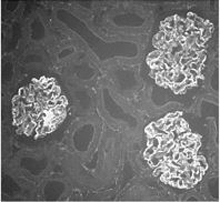anti-alpha-Actinin-4 pAb (IG-701)
| Code | Size | Price |
|---|
| AG-25T-0107-C050 | 50 ug | £440.00 |
Quantity:
Prices exclude any Taxes / VAT
Overview
Antibody Clonality: Polyclonal
Regulatory Status: RUO
Target Species:
- Bovine (Cattle)
- Hamster
- Human
- Mouse
- Porcine (pig)
Applications:
- Immunohistochemistry (IHC)
- Immunoprecipitation (IP)
- Western Blot (WB)
Shipping:
-20°C
Storage:
-20°C
Images
Documents
Further Information
Alternate Names/Synonyms:
F-actin Cross-linking Protein
Concentration:
250µg/ml
EClass:
32160000
Form (Short):
liquid
Formulation:
Liquid. In PBS containing 1mg/ml BSA and 0.01% sodium azide.
Handling Advice:
Avoid freeze/thaw cycles.
Immunogen:
Synthetic peptide corresponding to aa 27-38 of the N-terminal alpha-Actinin-4, coupled via a C-terminal cysteine residue to KLH.
Long Description:
Polyclonal Antibody. Recognizes human, mouse, rat, pig and Chinese hamster actinin-4. Does not cross-react with actinin-1, -2 or -3. Source: Rabbit. Applications: IHC, IP, WB. Liquid. In PBS containing 1mg/ml BSA and 0.01% sodium azide. alpha-Actinin 4 is an actin-bundling protein of ~100kDa that is associated with cell motility, endocytosis and cancer invasion. The alpha-actinin family comprises two non-muscle isoforms (alpha-actinin-1 and -4) and two skeletal muscle isoforms (alpha-actinin-2 and -3), with alpha-actinin-2 being also expressed in cardiac muscle. While alpha-actinin-4 is almost ubiquitously expressed, particularly high concentrations are found in glomeruli. On the subcellular level it is associated with actin stress fibers, but in certain cells it also localizes to the nucleus. Mutations in the alpha-actinin-4 gene cause an autosomal-dominant form of familial focal segmental glomerulosclerosis (FSGS), which is thought to result from a defect in glomerular podocyte function. A point mutation in the alpha-actinin-4 gene was found to generate an antigenic peptide that is recognized by autologous cytolytic T lymphocytes (CTL) on a human lung carcinoma. alpha-Actinin-4 interacts with a variety of proteins, including the ring finger protein BERP, the PDZ-LIM protein CLP-36, the hemidesmosomal and cell-cell contact protein BP180, and the tight junction protein MAGI-1. Moreover, alpha-actinin-4 forms a ternary complex with Ca2+/Calmodulin-dependent protein kinase II and densin-180, a protein of postsynaptic densities in CNS neurons. Ca2+-dependent association of alpha-actinin-4 with E3KARP is required for Ca2+-dependent inhibition of the Na+/H+ exchanger 3 (NHE3).
NCBI, Uniprot Number:
O43707
Package Type:
Plastic Vial
Product Description:
alpha-Actinin 4 is an actin-bundling protein of ~100kDa that is associated with cell motility, endocytosis and cancer invasion. The alpha-actinin family comprises two non-muscle isoforms (alpha-actinin-1 and -4) and two skeletal muscle isoforms (alpha-actinin-2 and -3), with alpha-actinin-2 being also expressed in cardiac muscle. While alpha-actinin-4 is almost ubiquitously expressed, particularly high concentrations are found in glomeruli. On the subcellular level it is associated with actin stress fibers, but in certain cells it also localizes to the nucleus. Mutations in the alpha-actinin-4 gene cause an autosomal-dominant form of familial focal segmental glomerulosclerosis (FSGS), which is thought to result from a defect in glomerular podocyte function. A point mutation in the alpha-actinin-4 gene was found to generate an antigenic peptide that is recognized by autologous cytolytic T lymphocytes (CTL) on a human lung carcinoma. alpha-Actinin-4 interacts with a variety of proteins, including the ring finger protein BERP, the PDZ-LIM protein CLP-36, the hemidesmosomal and cell-cell contact protein BP180, and the tight junction protein MAGI-1. Moreover, alpha-actinin-4 forms a ternary complex with Ca2+/Calmodulin-dependent protein kinase II and densin-180, a protein of postsynaptic densities in CNS neurons. Ca2+-dependent association of alpha-actinin-4 with E3KARP is required for Ca2+-dependent inhibition of the Na+/H+ exchanger 3 (NHE3).
Purity:
Antigen affinity purified.
Source / Host:
Rabbit
Specificity:
Recognizes human, mouse, rat, pig and Chinese hamster actinin-4. Does not cross-react with actinin-1, -2 or -3.
Transportation:
Non-hazardous
UNSPSC Category:
Primary Antibodies
UNSPSC Number:
12352203
Use & Stability:
Stable for at least 1 year after receipt when stored at -20°C.
References
Expression of alpha-actinin-4 in acquired human nephrotic syndrome: a quantitative immunoelectron microscopy study: N.P. Goode, et al.; Nephrol. Dial. Transplant. 19, 844 (2004) | The Relationship between Subcellular Localization of Actinin-4 and Cell Motility in Oral Squamous Cell Carcinoma: Y. Iida & H. Chiba; Oral Sci. Intern. 1, 30 (2004) | Parietal Podocytes in Normal Human Glomeruli: J. Beriety, et al.; JASN 17, 2770 (2006) | VASP-dependent regulation of actin cytoskeleton rigidity, cell adhesion, and detachment: A.B. Galler, et al.; Histochem. Cell Biol. 125, 457 (2006) | Extra-cellular matrix proteins induce re-distribution of alpha-actinin-1 and alpha-actinin-4 in A431 cells: A. Bolshakova, et al.; Cell Biol. Int. 31, 360 (2007) | Alpha-actinin is required for tightly regulated remodeling of the actin cortical network during cytokinesis: S. Mukhina, et al.; Dev. Cell 13, 554 (2007) | Expression of alpha-actinin-4 in human diabetic nephropathy: M. Kimura, et al.; Intern. Med. 47, 1099 (2008) | Expression of alpha-Actinin-1 in Human Glomerular Mesangial Cells In Vivo and In Vitro: C. Yang & W.F. Glass; Exp. Biol. Med. 233, 689 (2008) | Analysis of Nuclear Protein Complexes Comprising a-Actinin-4 by 2D-Electrophoresis and Mass Spectrometry: M. G. Khotin, et al.; Cell and Tissue Biology 3, 431 (2009) | Autophagy influences glomerular disease susceptibility and maintains podocyte homeostasis in aging mice: B. Hartleben, et al.; J. Clin. Invest. 120, 1084 (2010) | Molecular mechanisms underlying nucleocytoplasmic shuttling of actinin-4: M. Kumeta, et al.; J. Cell Sci. 123, 1020 (2010) | Albuminuria and Glomerular Damage in Mice Lacking the Metabotropic Glutamate Receptor 1: A. Puliti, et al.; Am. J. Pathol. 178, 1257 (2011) | Nephrotic Syndrome and Subepithelial Deposits in a Mouse Model of Immune-Mediated Anti-Podocyte Glomerulonephritis: C. Meyer-Schwesinger, et al.; J. Immunol. 187, 3218 (2011) | Ubiquitin C-terminal hydrolase-l1 activity induces polyubiquitin accumulation in podocytes and increases proteinuria in rat membranous nephropathy: C. Meyer-Schwesinger, et al.; Am. J. Pathol. 178, 2044 (2011) | Calcium sensitivity of alpha-actinin is required for equatorial actin assembly during cytokinesis: R. Jayadev, et al.; Cell Cycle 11, 1929 (2012) | Interaction of G-protein betagamma complex with chromatin modulates GPCR-dependent gene regulation: A. Bhatnagar, et al.; PLoS ONE 8, e52689 (2013)



